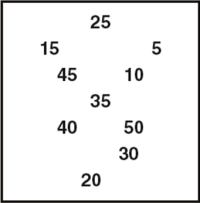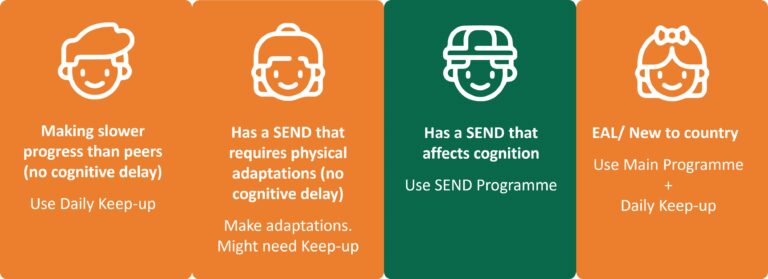The first aim of the proposed National Curriculum for Mathematics (2014) is to ensure that all pupils:
“become fluent in the fundamentals of mathematics, including through varied and frequent practice with increasingly complex problems over time, so that pupils have conceptual understanding and are able to recall and apply their knowledge rapidly and accurately to problems”.
Children become fluent in number through a combination of the following four elements:
- Developing strategic approaches to basic numerical skills
- Purposeful dialogue in pairs and as a group
- Effective activities to practise and consolidate their numerical skills
- Meaningful and informative self-assessment
Paired games are an excellent way to support the development of mental fluency in basic numerical skills as they provide:
- an opportunity for children to communicate with each other and develop new mathematical language
- a non-threatening and enjoyable way for children to consolidate their understanding of mathematical skills and concepts;
- a chance for children to use and apply mathematical skills and concepts which they have mastered in a more formal learning context;
- an informal assessment tool to help you determine whether children are able to use and apply mathematical skills in a real-life recreational setting;
- an opportunity for children to play co-operatively together.
The following are a selection of simple paired games to help develop children’s fluency in the recall of addition and subtraction number facts and the multiplication tables. These games can easily be adapted to other objectives.
 Objective: Recall addition and subtraction number facts to 20
Objective: Recall addition and subtraction number facts to 20
Resources: pencil and paper (per pair); 2 x 1 – 6 dice (per pair); 20 counters: 10 counters of one colour, 10 of another colour (per pair)
What to do:
- Write all the numbers from 0 to 20, making them big enough to put counters on.
- Decide who will have which colour counters.
- Take turns to roll one dice and put a counter on the number that goes with the dice number to make 20, e.g. roll a 6 and put a counter on 14.
- If someone else’s counter is on that number then replace it with one of your counters.
- The first player to have counters on 8 different numbers wins.
Variations:
- Put a counter on the number that goes with the dice number to make another total, e.g. 16.
- Roll two dice, e.g. 4 and 3. Subtract from 20 (or a number greater than 12) one of the numbers rolled or the total of the two numbers rolled, i.e. 4, 3 or 7 (4 + 3).
- Roll two dice, add the numbers together and look for a third number to total 20.
Objective: Recall addition and subtraction number facts to 20
Resources: pencil and paper (per pair); 2 x 0 – 9 or 1 – 12 dice (per pair)
What to do:
- Take turns to roll the dice and add the two numbers together.
- The player who has the larger total wins that round and scores the difference between the two totals. The other player scores zero. If the totals are the same, no one wins that round.
- Keep a running total of your score.
- The winner is the first player to reach 30 or more.
Variation:
- Take turns to roll the dice and find the difference between the two numbers.
- The player who has the greater difference wins that round and uses the difference as their score. If the differences are the same, no one wins that round.
- Keep a running total of your score.
- The winner is the first player to reach 20 or more.
Objective: Add and subtract a one-digit number to and from a two-digit number
Resources: pencil and paper (per pair); 3 x 1 – 6 or 0 – 9 dice (per pair)
What to do:
- Take turns to roll the dice, e.g. 4, 3, 6, and use the numbers to make a two-digit and a one-digit number, i.e. 63 and 4.
- Add the two numbers together, i.e. 63 + 4 = 67.
- The larger total wins that round.
- The overall winner is the first player to win 10 rounds.
Variation:
- Subtract the one-digit number from the two-digit number. The winner of the round is the player with the smaller answer.
Objective: Recall multiplication facts for multiplication tables up to 10 × 10
Resources: set of 1 – 10 number cards (per pair)
What to do:
- Shuffle the cards and place them face down in a pile.
- One player has the multiplication facts for the 2 multiplication table and the other player the multiplication facts for the 5 multiplication table.
- Take turns to quickly turn over a card.
- The first player to multiply the card number by their multiplication tables number and call out the correct answer keeps the card.
- The winner is the player with more cards once all 10 cards have been used.
Variations:
- Play the game again swapping multiplication tables.
- Play the game using other multiplication tables.
 Objective: Recall multiplication and division facts for multiplication tables up to 10 × 10
Objective: Recall multiplication and division facts for multiplication tables up to 10 × 10
Resources: pencil and paper (per pair); set of small 1 – 10 number cards (per pair)
What to do:
- Decide which multiplication table you want the children to practice and provide them with a sheet showing all the multiples to the tenth multiple of the multiplication table being practised.
- Shuffle the cards and place them face down in a pile.
- Take turns to turn over the top card, e.g. 6, say the number and multiply the number by the multiplication table you are practising.
- Use the number card to cover the answer.
- Keep going until all the numbers are covered.
- Finally, take turns to remove one card at a time from the paper, saying the number underneath before doing so.
Variation:
- Play the game using other multiplication tables.
Objective: Multiply a two-digit number by a one-digit number
Resources: pencil and paper (per pair); 3 x 1 – 6 or 0 – 9 dice (per pair)
What to do:
- Take turns to roll the dice, and use the dice numbers to make a two-digit number and a one-digit number, e.g. if you roll 2, 4 and 6, you could make 62 and 4.
- Multiply the two-digit number by the one-digit number, e.g. 62 x 4 = 248.
- The player with the larger answers wins that round.
- Play 5 rounds.
- The overall winner is the player who wins more rounds.
Objective: Divide a two-digit number by a one-digit number
Resources: pencil and paper (per pair); 3 x 1 – 6 or 0 – 9 dice (per pair)
What to do:
- Take turns to roll the dice, and use the dice numbers to make a two-digit number and a one-digit number, e.g. if you roll 2, 4 and 6, you could make 62 and 4.
- Divide the two-digit number by the one-digit number, e.g. 62 ÷ 4 = 15 R 2.
- The remainder is your score for that round. If there is no remainder score 0.
- Keep a running total of your score, the winner is the player with the larger score after 5 rounds.
Look out for further whole class, paired and individual games and activities later in the year that will help to support the development of mental fluency in basic numerical skills.
Peter Clarke, series editor, Collins New Primary Maths



